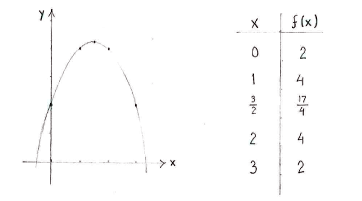Lösung 1.3:2b
Aus Online Mathematik Brückenkurs 2
(Unterschied zwischen Versionen)
K |
|||
| Zeile 1: | Zeile 1: | ||
| - | In order to determine the function's extreme points, we investigate three types of points | + | In order to determine the function's extreme points, we investigate three types of points, |
| - | + | # critical points, i.e. where <math>f^{\,\prime}(x)=0</math>, | |
| - | <math>{ | + | # points where the function is not differentiable, and |
| - | + | # endpoints of the interval of definition. | |
| - | + | ||
| - | + | ||
| - | + | ||
In our case, we have that: | In our case, we have that: | ||
| - | + | <ol> | |
| - | <math>f | + | <li>The derivative of <math>f(x)</math> is given by |
| - | is given by | + | {{Displayed math||<math>f^{\,\prime}(x) = 3-2x</math>}} |
| - | + | and becomes zero when <math>x=3/2\,</math>.</li> | |
| - | <math> | + | |
| + | <li>The function is a polynomial, and is therefore differentiable everywhere.</li> | ||
| - | + | <li>The function is defined for all ''x'', and therefore the interval of definition has no endpoints.</li> | |
| - | < | + | </ol> |
| - | + | There is thus just one point <math>x=3/2\,</math>, where the function possibly has an extreme point. | |
| - | + | If we write down a sign table for the derivative, we see that <math>x=3/2</math> is a local maximum. | |
| - | <math>x</math> | + | |
| - | + | ||
| - | There is thus a point | ||
| - | <math>x=\frac{3}{2}</math>, where the function possibly has an extreme point. | ||
| - | + | {| border="1" cellpadding="5" cellspacing="0" align="center" | |
| - | <math>x=\ | + | |- |
| - | + | |width="50px" align="center" style="background:#efefef;"| <math>x</math> | |
| + | |width="50px" align="center" style="background:#efefef;"| | ||
| + | |width="50px" align="center" style="background:#efefef;"| <math>\tfrac{3}{2}</math> | ||
| + | |width="50px" align="center" style="background:#efefef;"| | ||
| + | |- | ||
| + | |width="50px" align="center"| <math>f^{\,\prime}(x)</math> | ||
| + | |width="50px" align="center"| <math>+</math> | ||
| + | |width="50px" align="center"| <math>0</math> | ||
| + | |width="50px" align="center"| <math>-</math> | ||
| + | |- | ||
| + | |width="50px" align="center"| <math>f(x)</math> | ||
| + | |width="50px" align="center"| <math>\nearrow</math> | ||
| + | |width="50px" align="center"| <math>\tfrac{17}{4}</math> | ||
| + | |width="50px" align="center"| <math>\searrow</math> | ||
| + | |} | ||
| - | TABLE | ||
| - | Because the function is given by a second-degree expression, its graph is a parabola with a maximum at | + | Because the function is given by a second-degree expression, its graph is a parabola with a maximum at <math>(3/2, 17/4)</math> and we can draw it with the help of a few couple of points. |
| - | <math> | + | |
| - | and we can draw it with the help of a few couple of points. | + | |
| - | + | [[Image:1_3_2_b.gif||center]] | |
Version vom 12:46, 17. Okt. 2008
In order to determine the function's extreme points, we investigate three types of points,
- critical points, i.e. where \displaystyle f^{\,\prime}(x)=0,
- points where the function is not differentiable, and
- endpoints of the interval of definition.
In our case, we have that:
- The derivative of \displaystyle f(x) is given by
and becomes zero when \displaystyle x=3/2\,.\displaystyle f^{\,\prime}(x) = 3-2x - The function is a polynomial, and is therefore differentiable everywhere.
- The function is defined for all x, and therefore the interval of definition has no endpoints.
There is thus just one point \displaystyle x=3/2\,, where the function possibly has an extreme point.
If we write down a sign table for the derivative, we see that \displaystyle x=3/2 is a local maximum.
| \displaystyle x | \displaystyle \tfrac{3}{2} | ||
| \displaystyle f^{\,\prime}(x) | \displaystyle + | \displaystyle 0 | \displaystyle - |
| \displaystyle f(x) | \displaystyle \nearrow | \displaystyle \tfrac{17}{4} | \displaystyle \searrow |
Because the function is given by a second-degree expression, its graph is a parabola with a maximum at \displaystyle (3/2, 17/4) and we can draw it with the help of a few couple of points.

